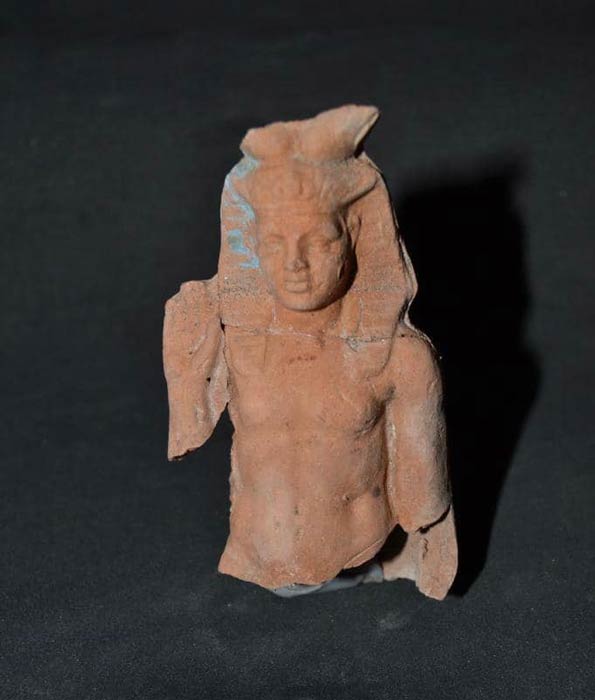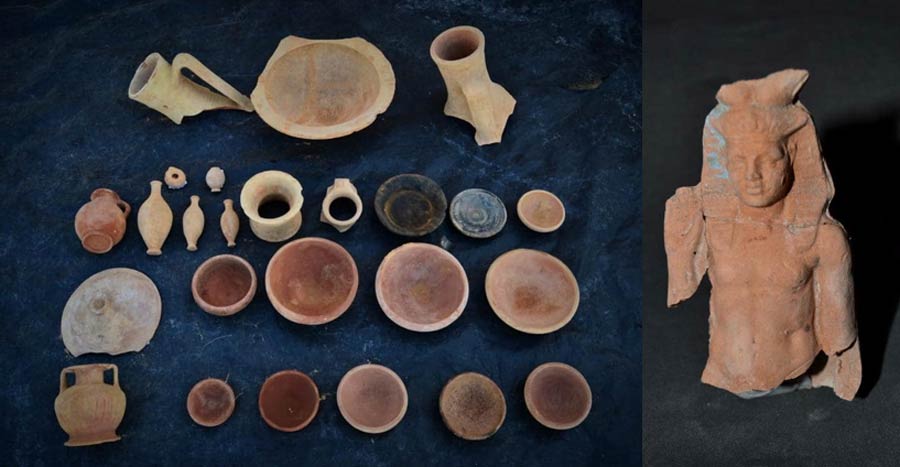Ancient Greek Pottery Workshop Provides Stunning Examples of Craft!
The Supreme Council of Antiquities had made an exciting discovery at the Tabet Al-Motaweh site west of Alexandria. An extensive Greek pottery workshop and storage area from the Ptolemaic era (305-30 BC) and Byzantine period (395-619 AD) of Alexandria was recently excavated by the team at Tabet Al-Motaweh.
A Facebook post by Egypt’s Ministry of Tourism and Antiquities has disclosed that the archaeological mission also found evidence that the ancient Greek pottery workshop was used for centuries. In the northern part of the facility, a cement-making kiln was found, probably dating to Egypt’s Byzantine era. Under one of the kilns, the burial of a pregnant woman was also found. Moreover, near the pottery workshop the living facilities of the workshop workers were found, shedding new light on this period of history in Egypt.

Part of the Greek pottery workshop from the Ptolemaic era, which was adjacent to a number of rooms used by the ceramic workers. (Ministry of Tourism and Antiquities)
Alexandria’s Greek Pottery Workshop and Workers’ Residence
According to the newspaper Ahram, Dr Mostafa Waziri, secretary-general of the Council, stated that the Greek pottery workshop housed a collection of pottery-firing kilns, two of them carved into rock, of which one is remarkably well preserved. For the compacting process, its entrance was blocked with clay and pottery sherds. The fuel for firing went in through a ramp carved into the rock located below this entrance.
Dr Ayman Ashmawy, Head of the Egyptian Antiquities section in the Antiquities Council revealed that a separate building to the south of the pottery kilns was also discovered and it was probably used to store clay utensils as a large collection of clay pots was found inside.
- Last of the Kings of Egypt: The Ptolemaic Dynasty
- Egyptian Archaeologists unearth large black sarcophagus in Alexandria

Close up for some pottery jars discovered. (Ministry of Tourism and Antiquities)
Evidently, the workers who manned the facility were also housed on the premises, at least temporarily. A separate group of limestone units dating back to the Ptolemaic period, the last dynasty to rule over Egypt, was also discovered not far from the Greek pottery workshop area. It was this group of units that seems to have provided all the requirements of daily living for the ceramic workers.
In total, archaeologists identified 13 rooms that were used for different purposes. Some were used as dorms for the workers. Other rooms contained stoves and cooking pots and amphorae with bones of animals such as pigs, sheep, goats and fish, and were presumably used as for cooking. There was also a room where mills, pestles, amphorae, weights of different types, and spindles were found, which may have been used for selling the pots.
A large number of coins mostly dating to the Ptolemaic era were found on the floor of one of the rooms, according to Mohaja Ramadan Abdel Qader, who headed the dig team. These coins have the faces of Alexander the Great, Zeus and Queen Cleopatra stamped on them.
Fishing hooks and the anchor of a boat provided evidence that the residents of the Greek pottery workshop facility practiced fishing.

The badly damaged remains of a statue of Harpocrates, the Greek god of silence, secrets, confidentiality, and hope, was also found at the Greek pottery workshop site as well as other religious or spiritual items. (Ministry of Tourism and Antiquities)
Religion and Ritual Formed an Important Part of Workers’ Lives
There was also a separate room used for conducting religious rituals. Here, on a raised platform, the badly damaged remains of a statue of Harpocrates, the god of silence, secrets, confidentiality and hope was found. Harpocrates was adapted by the Greeks of Ptolemaic Alexandria from the Egyptian child god Horus who represents the dawning sun, rising anew each day. The platform also held another, equally damaged statue of an as-yet unidentified royal.
Fragments of terracotta statues of goddesses, as well as mortal women, were also found by the archaeological team. An amulet and a feathered crown belonging to a statue of the minor Egyptian god Bes, represented as a dwarf with a large head, goggle eyes, protruding tongue, bowlegs, bushy tail and a crown of feathers, were also discovered. Bes was invoked to bring joy and drive away pain and sorrow as well as scare away evil spirits. He was also associated with music and childbirth.
The oldest use of the site appears to have been as a cemetery where burials were made in holes cut into the rock, and nearly 100 burials have been found so far. The cemetery predates the Greek pottery workshops, kilns, pottery-storage and worker-residence facilities that were evidently built over it.
- Ptolemaic Era Shipyard Unearthed Near Roman Fortress in Egypt
- Egyptian Alexandria - Ancient underwater finds revealed the Pharaonic roots of the Ptolemaic City
Converted from a cemetery into a bustling pottery-making workshop and self-sufficient worker residential complex, and then to a cement-making kiln, the ancient site of Tabet Al-Motaweh remained in continuous, if diverse use, over the centuries. Further excavations by the archaeological mission of Egypt’s Antiquities Council, planned for the coming months, will reveal more about the life of the ancient Alexandrians who utilized this site in life and in death.
Top image: This is just a small selection of the Greek pottery made at the Ptolemaic to Byzantine period ceramic workshop in Alexandria, Egypt, which was found near to the ceramic workers’ living quarters. Source: Ministry of Tourism and Antiquities
By Sahir Pandey
References
El-Aref N. 2022. Graeco-Roman pottery workshop, storage facility unearthed in Alexandria. Available at: https://english.ahram.org.eg/News/464431.aspx
Greek City Times. 2022. Ancient Greek pottery workshop and storage facility discovered in Alexandria. Available at: https://greekcitytimes.com/2022/04/12/ancient-greek-workshop-alexandria/
Ministry of Tourism and Antiquities Egypt. 2022. The discovery of a workshop for the manufacture of pottery in Alexandria Governorate. Available at: https://www.facebook.com/tourismandantiq?__cft__[0]=AZVobbCtCTm2u2kvmvpnCXDh8kx01x5LQMsLa6sMtaNtjRsry3dfb11bIypk7K0iMNap8GlkYul7rM5u4dyqknuZQGsQxdAtR1QF2G1ltisZ_C2HNo9pmJME3hIbuA-cdwl0CzkyztWDrwaDrHJuBZVu&__tn__=-UC%2CP-R



















